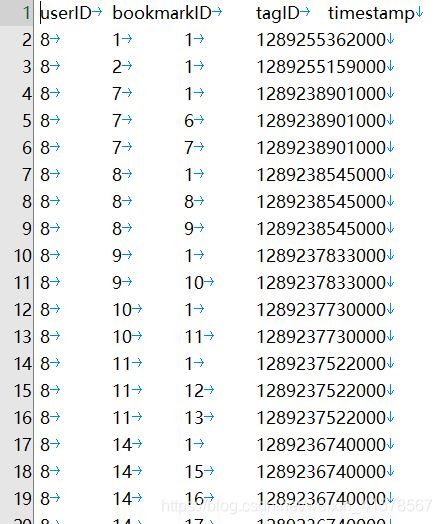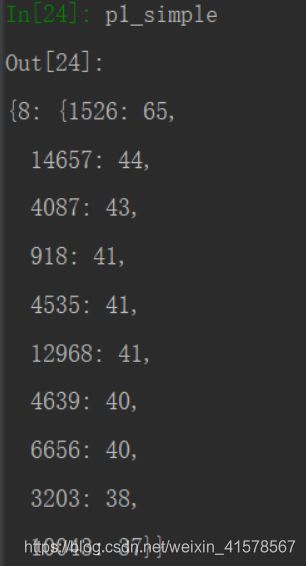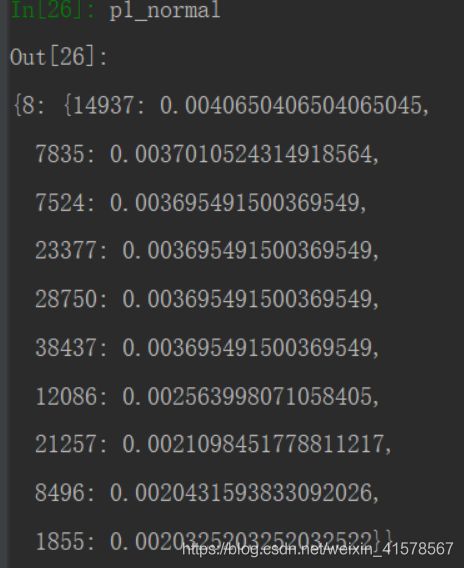python 基于标签的推荐Tag-based及SimpleTagBased、TagBased-TFIDF等算法实现
python 基于标签的推荐Tag-based及SimpleTagBased、TagBased-TFIDF等算法实现
-
-
- 1. 概览
- 2. 基本概念
-
- 2.1 用户画像
-
- 2.1.1 定义
- 2.1.2 步骤
- 2.1.3 标签来源
- 2.1.4 标签相关的数据结构
- 2.1.5 如何给用户推荐标签
- 2.2 Simple Tag-based
-
- 2.2.1 计算公式
- 2.3 Norm Tag-based
-
- 2.3.1 计算公式
- 2.4 Tag-based TFIDF
-
- 2.4.1 计算公式
- 3. 代码实现
-
-
- 3.1 数据介绍
- 3.2 基于pandas dataframe的标签推荐
-
- 3.2.1 python代码
- 3.2.2 结果展示
-
-
1. 概览
本篇主要介绍关于推荐算法相关的知识:基于标签的推荐,涉及了3个原理较简单的计算方法(Simple Tag-based、Normal Tag-based、Tag-based-Tfidf ),以及基于pandas dataframe的python代码实现。
dataframe的效率比用字典实现低很多,主要是因为该算法涉及到较多的取值操作,字典的取值的平均时间复杂度当然要比dataframe用loc快很多。
2. 基本概念
2.1 用户画像
2.1.1 定义
用户画像毋庸置疑,即是对用户行为特征的总结归纳和描述,以更好的提升业务质量。
2.1.2 步骤
- 定义全局的用户唯一标识id(例如身份证、手机号、用户id等)
- 给用户打标签
- 根据标签为为业务带来不同阶段的收益。在用户生命周期的3个阶段:获客、粘客、留客 中,根据各类的用户数据对用户进行标签化、用户画像等,尽最大限度对用户进行留存。
2.1.3 标签来源
-
PGC:通过工作人员进行打标签(质量高,数据规范)
通过聚类算法对物品进行降为形成不同的标签。物品的标签化,本身是对物品的降维,所以可以利用聚类、降维的方法进行物品标签的生成。目前主流的聚类方法有:Kmeans,EM,DBScan,层级聚类,PCA等等。
-
UGC:通过用户进行打标签(质量低,数据不规范)
2.1.4 标签相关的数据结构
- 用户打标签的记录【user_id, item_id, tag】
- 用户打过的标签【user_id, tag】
- 用户打过标签的item【user_id, item】
- 打上某标签的item【tag, item】
- 同样打过某标签的用户【tag, user_id】
2.1.5 如何给用户推荐标签
根据用户的标签行为数据,通过SimpleTagBased 、 NormTagBased 及 TagBased-TFIDF 等方法,当用户A给某item打了标签T,进行以下4种类型的推荐:
-
给用户A推荐系统中热门标签的item
-
item上有热门的标签T-hot,给用户A推荐其他打了T-hot标签的items
-
用户自己经常对不同item打上标签T1等,对同样有T1标签的其他item进行推荐
-
将以上几种进行融合。
2.2 Simple Tag-based
2.2.1 计算公式
s c o r e ( u , i ) = ∑ t u s e r _ t a g s [ u , t ] ∗ t a g _ i t e m s [ t , i ] score(u, i)=\sum_t{user\_tags[u, t] * tag\_items[t, i]} score(u,i)=t∑user_tags[u,t]∗tag_items[t,i]
其中 user_tags[u,t] 表示【用户u使用标签t的次数】,tag_items[t, i] 表示【物品i被打上标签t的次数】
2.3 Norm Tag-based
2.3.1 计算公式
s c o r e ( u , i ) = ∑ t u s e r _ t a g s [ u , t ] u s e r _ t a g s [ u ] ∗ t a g _ i t e m s [ t , i ] t a g _ i t e m s [ t ] score(u,i)=\sum_t{\frac{user\_tags[u, t]}{user\_tags[u]} * \frac{tag\_items[t, i]}{tag\_items[t]}} score(u,i)=t∑user_tags[u]user_tags[u,t]∗tag_items[t]tag_items[t,i]
其中 user_tags[u] 表示【用户u打标签的总次数】,tag_items[t] 表示【标签t被使用的总次数】
2.4 Tag-based TFIDF
2.4.1 计算公式
s c o r e ( u , i ) = ∑ t u s e r _ t a g s [ u , t ] l o g ( 1 + t a g _ u s e r s [ t ] ) ∗ t a g _ i t e m s [ t , i ] score(u,i)=\sum_t{\frac{user\_tags[u, t]}{log(1 + tag\_users[t])} * tag\_items[t, i]} score(u,i)=t∑log(1+tag_users[t])user_tags[u,t]∗tag_items[t,i]
其中 tag_users[t] 表示【标签t被用户使用的总次数】
3. 代码实现
3.1 数据介绍

标准的userID -> bookmarkID -> tagID 记录行数据
3.2 基于pandas dataframe的标签推荐
3.2.1 python代码
# -*- coding: utf-8 -*-
"""
Created on 2020/11/18 13:54
@author: Irvinfaith
@email: [email protected]
"""
import operator
import time
import random
import pandas as pd
import numpy as np
class TagBased(object):
def __init__(self, data_path, sep='\t'):
self.data_path = data_path
self.sep = sep
self.calc_result = {
}
self.table = self.__load_data(data_path, sep)
def __load_data(self, data_path, sep):
table = pd.read_table(data_path, sep=sep)
return table
def __calc_frequency(self, table):
# user -> item
user_item = table.groupby(by=['userID','bookmarkID'])['tagID'].count()
# user -> tag
user_tag = table.groupby(by=['userID', 'tagID'])['bookmarkID'].count()
# tag -> item
tag_item = table.groupby(by=['tagID', 'bookmarkID'])['userID'].count()
# tag -> user
tag_user = table.groupby(by=['tagID', 'userID'])['bookmarkID'].count()
return {
"user_item": user_item, "user_tag": user_tag, "tag_item": tag_item, "tag_user": tag_user}
def train_test_split(self, ratio, seed):
return self.__train_test_split(self.table, ratio, seed)
def __train_test_split(self, table, ratio, seed):
random.seed(seed)
t1 = time.time()
stratify_count = table.groupby(by='userID')['userID'].count()
stratify_df = pd.DataFrame({
"count":stratify_count})
stratify_df['test_num'] = (stratify_df['count'] * ratio ).apply(int)
test_id = []
train_id = []
"""
==========================================
# 方法 1:dataframe的iterrows遍历行
# 10次执行平均耗时约 2.3秒
==========================================
# for index, row in stratify_df.iterrows():
# tmp_ids = table[table['userID'] == index].index.tolist()
# tmp_test_id = random.sample(tmp_ids, row['test_num'])
# test_id.extend(tmp_test_id)
# train_id.extend(list(set(tmp_ids) -set(tmp_test_id)))
==========================================
# 方法 2:series map和dataframe apply
# 10次执行平均耗时约 2.2秒
==========================================
按理来说,apply + map会比 iterrows 快很多,可能下面这个写法存储了较多的list,主要是为了方便查看拆分的结果,
所以在遍历取数的时候会花费更多的时间。
虽然apply+map方法只比iterrows快了0.1秒左右,但是在写法上我还是喜欢用apply+map。
"""
stratify_df['ids'] = stratify_df.index.map(lambda x: table[table['userID'] == x].index.tolist())
stratify_df['test_index'] = stratify_df.apply(lambda x: random.sample(x['ids'], x['test_num']), axis=1)
stratify_df['train_index'] = stratify_df.apply(lambda x: list(set(x['ids']) - set(x['test_index'])), axis=1)
stratify_df['test_index'].apply(lambda x: test_id.extend(x))
stratify_df['train_index'].apply(lambda x: train_id.extend(x))
train_data = table.iloc[train_id].reset_index(drop=True)
test_data = table.iloc[test_id].reset_index(drop=True)
print("Split train test dataset by stratification, time took: %.4f" % (time.time() - t1))
return {
"train_data": train_data, "test_data": test_data}
def __calc_item_recommendation(self, user_id, user_item, user_tag, tag_item, n, method):
marked_item = user_item[user_id].index
recommend = {
}
# t1 = time.time()
# user_id -> tag -> item -> count
marked_tag = user_tag.loc[user_id]
marked_tag_sum = marked_tag.values.sum()
for tag_index, tag_count in marked_tag.iteritems():
selected_item = tag_item.loc[tag_index]
selected_item_sum = selected_item.values.sum()
tag_selected_users_sum = self.calc_result['tag_user'].loc[tag_index].values.sum()
for item_index, tag_item_count in selected_item.iteritems():
if item_index in marked_item:
continue
if item_index not in recommend:
if method == 'norm':
recommend[item_index] = (tag_count / marked_tag_sum) * (tag_item_count / selected_item_sum)
elif method == 'simple':
recommend[item_index] = tag_count * tag_item_count
elif method == 'tfidf':
recommend[item_index] = tag_count / np.log(1 + tag_selected_users_sum) * tag_item_count
else:
raise TypeError("Invalid method `{}`, `method` only support `norm`, `simple` and `tfidf`".format(method))
else:
if method == 'norm':
recommend[item_index] += (tag_count / marked_tag_sum) * (tag_item_count / selected_item_sum)
elif method == 'simple':
recommend[item_index] += tag_count * tag_item_count
elif method == 'tfidf':
recommend[item_index] += tag_count / np.log(1 + tag_selected_users_sum) * tag_item_count
else:
raise TypeError("Invalid method `{}`, `method` only support `norm`, `simple` and `tfidf`".format(method))
# print(time.time() - t1)
sorted_recommend = sorted(recommend.items(), key=lambda x: (x[1]), reverse=True)[:n]
return {
user_id: dict(sorted_recommend)}
def __eval(self, train_recommend, test_data):
user_id = [i for i in train_recommend.keys()][0]
test_data_item = test_data['bookmarkID'].unique()
tp = len(set(test_data_item) & set(train_recommend[user_id].keys()))
# for item_id in test_data_item:
# if item_id in train_recommend[user_id]:
# tp += 1
return tp
def fit(self, train_data):
self.calc_result = self.__calc_frequency(train_data)
def predict(self, user_id, n, method='simple'):
return self.__calc_item_recommendation(user_id,
self.calc_result['user_item'],
self.calc_result['user_tag'],
self.calc_result['tag_item'],
n,
method)
def eval(self, n, test_data):
t1 = time.time()
test_data_user_id = test_data['userID'].unique()
total_tp = 0
tpfp = 0
tpfn = 0
check = []
for user_id in test_data_user_id:
train_recommend = self.predict(user_id, n)
user_test_data = test_data[test_data['userID'] == user_id]
total_tp += self.__eval(train_recommend, user_test_data)
tpfn += len(user_test_data['bookmarkID'].unique())
tpfp += n
check.append((user_id, total_tp, tpfn, tpfp))
recall = total_tp / tpfn
precision = total_tp / tpfp
print("Recall: %10.4f" % (recall * 100))
print("Precision: %10.4f" % (precision * 100))
print(time.time() - t1)
return recall, precision, check
if __name__ == '__main__':
file_path = "user_taggedbookmarks-timestamps.dat"
tb = TagBased(file_path, '\t')
train_test_data = tb.train_test_split(0.2, 88)
tb.fit(train_test_data['train_data'])
calc_result = tb.calc_result
# 使用3种方法,预测用户id为8 的排序前10的item
p1_simple = tb.predict(8, 10)
p1_tf = tb.predict(8, 10, method='tfidf')
p1_normal = tb.predict(8, 10, method='norm')


